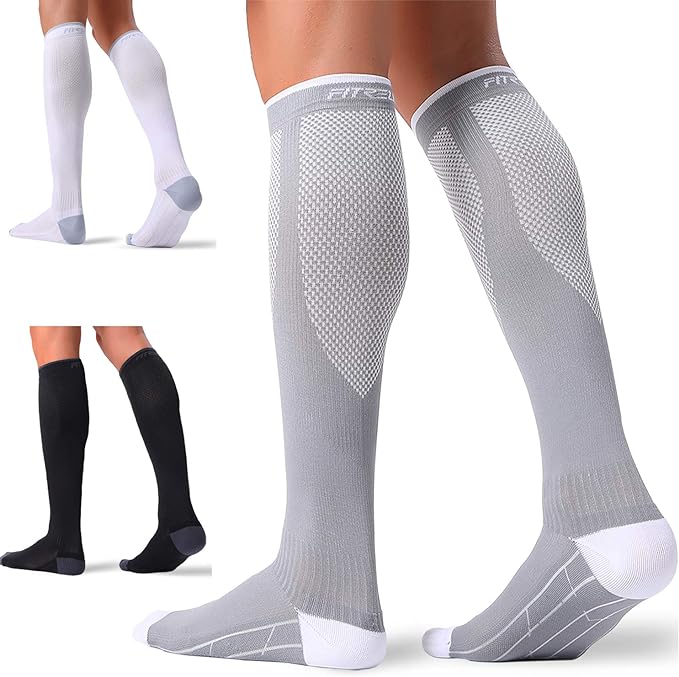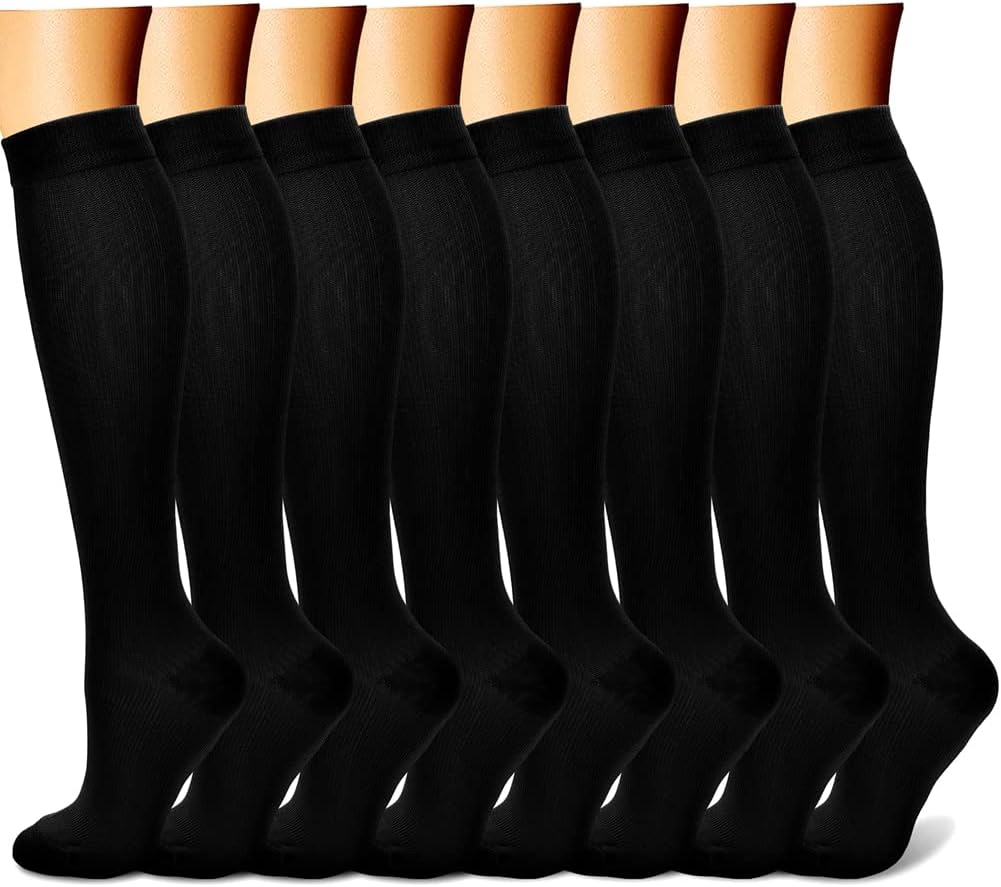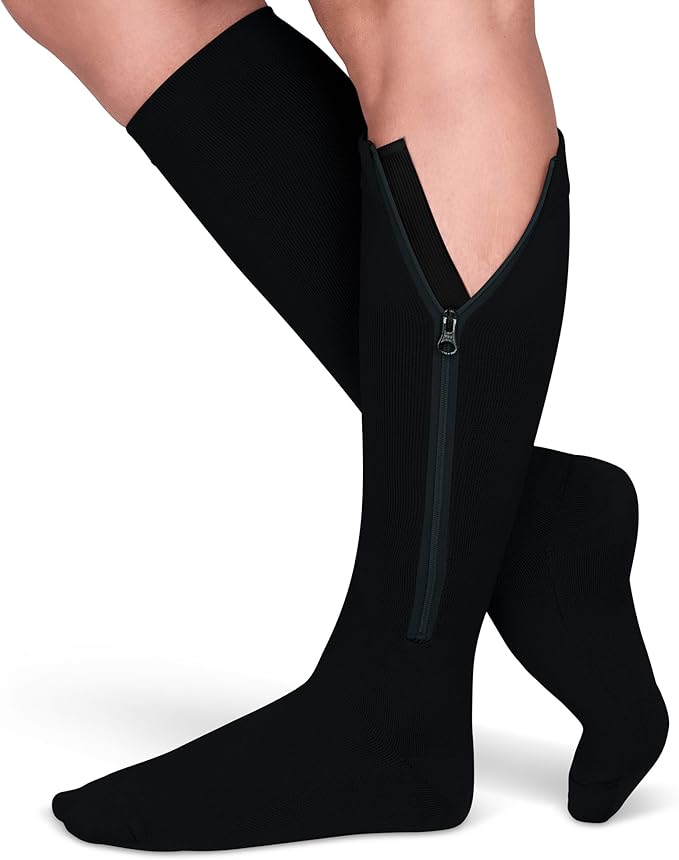Compression Socks Size Chart
Select your size to view detailed information about the compression socks.
Looking for the perfect fit? Check Out These Best-Selling Compression Socks.






Compression Socks Size Chart – A Complete Guide to Choosing the Right Fit for Your Needs
Compression socks are an essential accessory for athletes, healthcare professionals, and individuals dealing with circulation issues or long periods of standing or sitting. These socks are designed to apply gentle pressure to the legs and feet, helping to improve blood flow, reduce swelling, and alleviate discomfort. However, to reap the full benefits of compression socks, it is important to choose the right size. A proper fit ensures the socks work effectively without causing discomfort or restricting movement.
We will guide you through the importance of compression socks, how to choose the right size based on your measurements, and what factors to consider when selecting compression socks. Additionally, we will provide you with a comprehensive compression socks size chart, tips on how to measure your legs, and advice on which compression level to choose based on your specific needs.
What Are Compression Socks?
Compression socks are specially designed garments that apply pressure to the legs and feet. This pressure helps to improve blood circulation, reduce swelling, and prevent the formation of blood clots. Compression socks come in different levels of pressure, lengths, and materials, depending on the intended use. They are commonly worn by athletes, pregnant women, travelers, and individuals with certain medical conditions, such as varicose veins or deep vein thrombosis (DVT).
Compression socks are typically made from elastic fabrics that exert graduated pressure. The socks apply the most pressure at the ankle and gradually decrease as they move up the leg. This design helps to encourage proper blood flow, reducing the risk of fluid retention and promoting quicker recovery after exercise.
Benefits of Wearing Compression Socks
Compression socks are known for providing a wide range of benefits, which include:
1. Improved Circulation
The primary purpose of compression socks is to enhance circulation in the legs and feet. The gentle pressure from the socks helps blood flow back toward the heart, preventing blood from pooling in the lower extremities.
2. Reduction of Swelling
Swelling in the feet, ankles, and legs is common after prolonged standing, sitting, or exercise. Compression socks help reduce swelling by supporting the veins and lymphatic system, promoting fluid movement and preventing fluid buildup in the lower legs.
3. Enhanced Athletic Performance and Recovery
Athletes often use compression socks to improve performance and accelerate recovery. Compression socks help reduce muscle soreness and fatigue after intense physical activity by promoting better circulation and reducing muscle vibration.
4. Prevention of Varicose Veins
Compression socks can help prevent or alleviate varicose veins by promoting better circulation and reducing the strain on the veins. They can be especially beneficial for people who spend long hours on their feet or have a family history of varicose veins.
5. Post-Surgical Support
After surgery, particularly on the legs, compression socks are commonly recommended to reduce swelling and the risk of blood clots. They provide support and promote healing during recovery.
6. Comfort During Long Travel
For individuals who are traveling long distances, whether by plane, train, or car, wearing compression socks can prevent discomfort associated with sitting for long periods. The socks help to reduce the risk of deep vein thrombosis (DVT) and swelling in the legs and feet.
Why Is Sizing Important for Compression Socks?
When it comes to compression socks, sizing is crucial. Wearing socks that are too tight or too loose can undermine their effectiveness and cause discomfort. If compression socks are too tight, they may restrict blood flow, leading to complications such as numbness, tingling, or pain. On the other hand, if they are too loose, they won’t provide the necessary pressure to improve circulation and reduce swelling.
To ensure you get the maximum benefit from compression socks, you need to select the right size based on your leg measurements. This is where a compression socks size chart comes in handy.
How to Measure for Compression Socks
To find the correct size for compression socks, you’ll need to take accurate measurements of your legs. Here’s how to do it:
1. Measure Your Ankle Circumference
- Where to measure: Measure around the narrowest part of your ankle, just above the bony prominence (the ankle bone).
- Why: The ankle is the part of the leg where compression socks should exert the most pressure, so an accurate ankle measurement is crucial for determining the proper fit.
2. Measure Your Calf Circumference
- Where to measure: Measure around the widest part of your calf muscle.
- Why: The calf circumference is important because compression socks are designed to provide gradual pressure, with the most compression at the ankle and decreasing as the socks move up the leg.
3. Measure the Length of Your Leg
- Where to measure: Measure the length from the floor to the bend in the back of your knee. This measurement is needed if you are selecting knee-high or thigh-high compression socks.
- Why: The length of your leg helps determine how long the compression socks should be to provide proper coverage and support.
4. Consider Your Shoe Size (Optional)
Some compression socks, particularly those that come in a variety of sizes such as S, M, L, and XL, may also use shoe size as a reference point. If your measurements fall between two sizes, it’s often helpful to consider your shoe size as an additional guide.
Compression Socks Size Chart
To help you choose the right compression sock size, here’s a general size chart based on ankle, calf, and leg measurements:
| Size | Ankle Circumference | Calf Circumference | Leg Length | Shoe Size (if applicable) |
|---|---|---|---|---|
| XS | 7-8 inches (18-20 cm) | 10-13 inches (25-33 cm) | 12-14 inches (30-35 cm) | 4-6 (women) / 3-5 (men) |
| S | 8-9 inches (20-23 cm) | 13-15 inches (33-38 cm) | 14-16 inches (35-40 cm) | 6-8 (women) / 5-7 (men) |
| M | 9-10 inches (23-25 cm) | 15-17 inches (38-43 cm) | 16-18 inches (40-45 cm) | 8-10 (women) / 7-9 (men) |
| L | 10-11 inches (25-28 cm) | 17-19 inches (43-48 cm) | 18-20 inches (45-50 cm) | 10-12 (women) / 9-11 (men) |
| XL | 11-12 inches (28-30 cm) | 19-21 inches (48-53 cm) | 20-22 inches (50-55 cm) | 12-14 (women) / 11-13 (men) |
| XXL | 12-13 inches (30-33 cm) | 21-23 inches (53-58 cm) | 22-24 inches (55-60 cm) | 14+ (women) / 13+ (men) |
Choosing the Right Compression Level
Compression socks come in different compression levels, which are typically measured in millimeters of mercury (mmHg). The compression level determines the amount of pressure the socks apply to your legs. The right compression level depends on your needs, whether you’re using the socks for athletic performance, medical reasons, or general comfort.
Light Compression (8-15 mmHg)
- Best for: General discomfort, tired or achy legs, and mild swelling. Light compression is often used for travel and everyday wear.
- Pressure: Provides a gentle squeeze, ideal for people who don’t have severe circulation problems.
Moderate Compression (15-20 mmHg)
- Best for: Preventing varicose veins, reducing mild swelling, and enhancing recovery post-workout.
- Pressure: Provides moderate pressure, offering support for everyday activities and low-impact sports.
Firm Compression (20-30 mmHg)
- Best for: Severe varicose veins, chronic venous insufficiency, and post-surgical recovery. This level of compression is commonly used for medical conditions that affect circulation.
- Pressure: Ideal for people who need therapeutic support, especially those with significant swelling or circulatory issues.
Extra Firm Compression (30-40 mmHg)
- Best for: More severe circulation issues such as deep vein thrombosis (DVT), severe varicose veins, or post-surgical edema.
- Pressure: Strong, therapeutic compression that provides significant relief for those with serious medical conditions.
How to Wear Compression Socks
Wearing compression socks correctly is crucial to experiencing the full benefits. Here are some tips on how to wear compression socks effectively:
- Put them on in the morning: It’s best to put on compression socks in the morning when your legs are not swollen. If you wait until later in the day, it may be harder to get the socks on, and they may not provide optimal compression.
- Wear them for the recommended time: Depending on the compression level, you may need to wear your socks for a few hours or all day. If you’re wearing them for recovery or athletic performance, you may only need to wear them during or after your workout. For medical purposes, it’s essential to follow your doctor’s advice.
- Avoid folding or rolling: To get the maximum benefit from compression socks, avoid folding or rolling the top of the socks. This can reduce the effectiveness of the compression and may cause discomfort.
- Care for your socks properly: Compression socks should be washed regularly to maintain their elasticity and effectiveness. Always follow the manufacturer’s care instructions, usually involving gentle hand washing or machine washing on a delicate cycle.
FAQs About Compression Socks Size Chart
1. Why is it important to use a compression socks size chart?
Proper sizing ensures the socks provide the right level of compression, comfort, and circulation support. Ill-fitting socks can be ineffective or even harmful.
2. What measurements are needed for compression socks sizing?
Most charts require:
- Ankle circumference (narrowest part above the ankle bone)
- Calf circumference (widest part of the calf)
- Leg length (heel to knee for knee-highs)
Some charts may also include shoe size for reference.
3. Are compression sock sizes the same as regular sock sizes?
No. Compression socks use a different sizing system based on limb measurements, not just foot or shoe size.
4. What do compression levels like 15–20 mmHg or 20–30 mmHg mean?
These numbers indicate pressure levels:
- 8–15 mmHg: Mild support
- 15–20 mmHg: Moderate compression (for travel, mild swelling)
- 20–30 mmHg: Firm compression (for varicose veins, pregnancy)
- 30–40 mmHg: Medical-grade (under doctor supervision)
5. Can I use shoe size to choose compression socks?
Some brands offer size guides that include shoe sizes, but ankle and calf measurements provide the most accurate fit—especially for medical or sports use.
6. Do men’s and women’s compression socks have different sizing charts?
Some brands use unisex sizing, while others have separate charts for men and women due to anatomical differences. Always check the product label.
7. What if I’m between sizes on the chart?
If you’re between sizes:
- Prioritize ankle fit first
- Choose smaller size for a snugger compression
- Choose larger size for more comfort, especially if you’re on the borderline
8. How should compression socks feel when worn?
They should feel snug and supportive but not painfully tight. You should not feel tingling, numbness, or restricted blood flow.
9. Can compression socks help with swelling and fatigue?
Yes. Correctly sized compression socks improve blood flow, reduce swelling, and prevent fatigue—especially during travel, work, or long periods of standing.
10. Are there different size charts for knee-high and thigh-high compression socks?
Yes. Thigh-high or full-leg styles require additional measurements like thigh circumference and leg length. Always refer to the correct chart for the style you’re buying.
11. How often should I recheck my size?
Every 6–12 months or after:
- Weight changes
- Pregnancy
- Surgery or injury
- New medical conditions
12. Where can I find a reliable compression sock size chart?
On the manufacturer’s website, product packaging, or medical supply retailer. Some also offer printable measuring guides or apps.
13. What if I need help measuring correctly?
Use a soft measuring tape and follow brand-specific instructions. You can also ask a pharmacist, medical professional, or customer service rep for guidance.
Conclusion
Compression socks are an incredibly valuable tool for improving circulation, reducing swelling, and enhancing recovery during and after physical activity. Selecting the right size and compression level is essential for ensuring that the socks work effectively and provide the support you need. By following the measurement guidelines and using the size chart provided, you can find the perfect fit for your compression socks, allowing you to enjoy their many benefits.
Whether you are an athlete looking to boost performance, a traveler seeking comfort on long flights, or someone dealing with medical conditions such as varicose veins, compression socks can play a significant role in your health and well-being. Don’t underestimate the importance of choosing the right size—your comfort and health depend on it!






